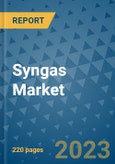This comprehensive analysis delves into the dynamic global syngas market, shedding light on its current status, growth drivers, and future opportunities.
The syngas market's journey is characterized by a growing demand for sustainable energy sources, a surge in chemical industry needs, and technological innovations. Despite challenges, the market is set for growth as companies prioritize environmental responsibility and technological progress in the field of syngas and its derivatives.
This product will be delivered within 1-3 business days.
Market Size and Growth
The syngas market reached a valuation of USD 45.2 billion in 2021 and is projected to achieve a steady CAGR of 5.8 percent during the forecast period. The growing demand for syngas and its derivatives is driven by their diverse applications in sectors like liquid fuels, gaseous fuels, chemicals, and power generation. Syngas offers a significant contribution to environmental protection through waste reduction, making it an environmentally conscious choice in both urban and rural areas. Notably, the market is witnessing a surge in demand for electricity generation and chemical production using syngas.Market Drivers
The market's growth is powered by a multitude of factors. The chemical industry's increasing demand for synthetic gas is a major driver, considering that syngas is integral in producing synthetic natural gas (SNG), which is then converted into liquefied natural gas (LNG) and compressed natural gas (CNG) for use in various transport sectors. The advantages of syngas, such as its low energy cost, stability, and utilization in power generation through gas engines, further contribute to its global demand. The emergence of underground coal gasification (UCG) technology eliminates the need to transport feedstock to gasification plants, leading to substantial cost savings and increased demand for syngas.COVID-19 Impact and Recovery
The global COVID-19 pandemic did impact the syngas market, causing slow growth due to disruptions in the supply chain. However, players like Linde plc showcased resilience by initiating new production plants even during challenging times. The steady recovery of the market is anticipated as the pandemic subsides.Segmental Insights
The syngas market's growth is driven by the dominance of segments such as coal and chemicals. Steam reforming is poised for rapid growth due to its efficiency and reliability, and technology pioneers like Haldor Topsoe A/S are contributing to this growth through innovations.Regional Landscape
North America is expected to dominate the syngas market due to its increasing demand for liquid fuels, power, and sustainable energy sources. The region's advancements in technology and infrastructure further support market growth. Asia-Pacific is projected to experience the fastest growth rate, driven by the demand for syngas and derivatives in China, India, and Japan, for chemicals, fuel, and electricity production.Competitive Landscape
Players like Shell PLC and Tokyo Gas Co. are collaborating to drive decarbonization initiatives. Innovations by companies like Haldor Topsoe A/S and Air Products and Chemicals Inc. are contributing to the industry's growth, emphasizing technological advancements and sustainable practices.The syngas market's journey is characterized by a growing demand for sustainable energy sources, a surge in chemical industry needs, and technological innovations. Despite challenges, the market is set for growth as companies prioritize environmental responsibility and technological progress in the field of syngas and its derivatives.
This product will be delivered within 1-3 business days.
Table of Contents
1. Executive Summary
2. Market Overview
3. Production Output and Trade Statistics, 2018 - 2022
4. Price Trends Analysis and Future Projects, 2018 - 2030
5. Global Syngas Market Outlook, 2018 - 2030
6. North America Syngas Market Outlook, 2018 - 2030
7. Europe Syngas Market Outlook, 2018 - 2030
8. Asia Pacific Syngas Market Outlook, 2018 - 2030
9. Latin America Syngas Market Outlook, 2018 - 2030
10. Middle East & Africa Syngas Market Outlook, 2018 - 2030
11. Competitive Landscape
12. Appendix
Companies Mentioned
- Air Products and Chemicals, Inc.
- Linde plc
- Air Liquide S.A.
- Topsoe
- Casale
- Johnson Matthey
- Sasol Limited
- NextChem S.p.A.
- Celanese Corporation
- Shell Plc
- SINOPEC
- Synthesis Energy Systems, Inc.
Methodology

LOADING...








